Radical Intimacies: Flavia Ventura's Artistic Rebellion
Flavia Ventura, recipient of the September myma artist grant, explores the complex terrain of bodily autonomy, challenging artistic conventions through her provocative investigations of sexuality, power, and transformation.

In conversation with Anna Berghuis, Flavia Ventura, the September '24 myma artist grant recipient, reveals the profound trajectory of her artistic exploration, where sexuality, power, and transformation collide. Ventura, a Brazilian artist based in São Paulo, examines the intricate ways bodies navigate systems of control, resistance, and liberation. Her multidisciplinary practice spans painting, performance, and critical theory, each medium interrogating the complex narratives of gender, pleasure, and personal autonomy. Ventura's provocative approach invites viewers to question established power structures, where seemingly fixed boundaries of sexuality and identity are revealed as fluid, dynamic landscapes of radical potential.
Congratulations on winning the September Myma grant! Can you tell us a bit about yourself and your practice?
First of all, I would like to express my gratitude to Myma and Visionary Projects for the grant. I am glad and honored. I am Brazilian from Minas Gerais, where I lived for most of my life. There, I studied and worked with fashion, and later transitioned into visual arts. I have been living in São Paulo for almost three years now, mainly working with painting. Even in painting, I maintain a very strong drawing mindset and consider myself a drawer before anything else. Since everything is drawing, I think labeling myself as a painter feels like a kind of limitation, because a painter makes paintings, but a drawer makes anything. My work spans performance, installation, photography, sculpture, objects, words, and all other forms of drawing. Moreover, perhaps my greatest interest in art lies in the process, and I believe that drawing carries a much more process-oriented nature, whereas painting has something of completion or durability that, for me, doesn’t make much sense.
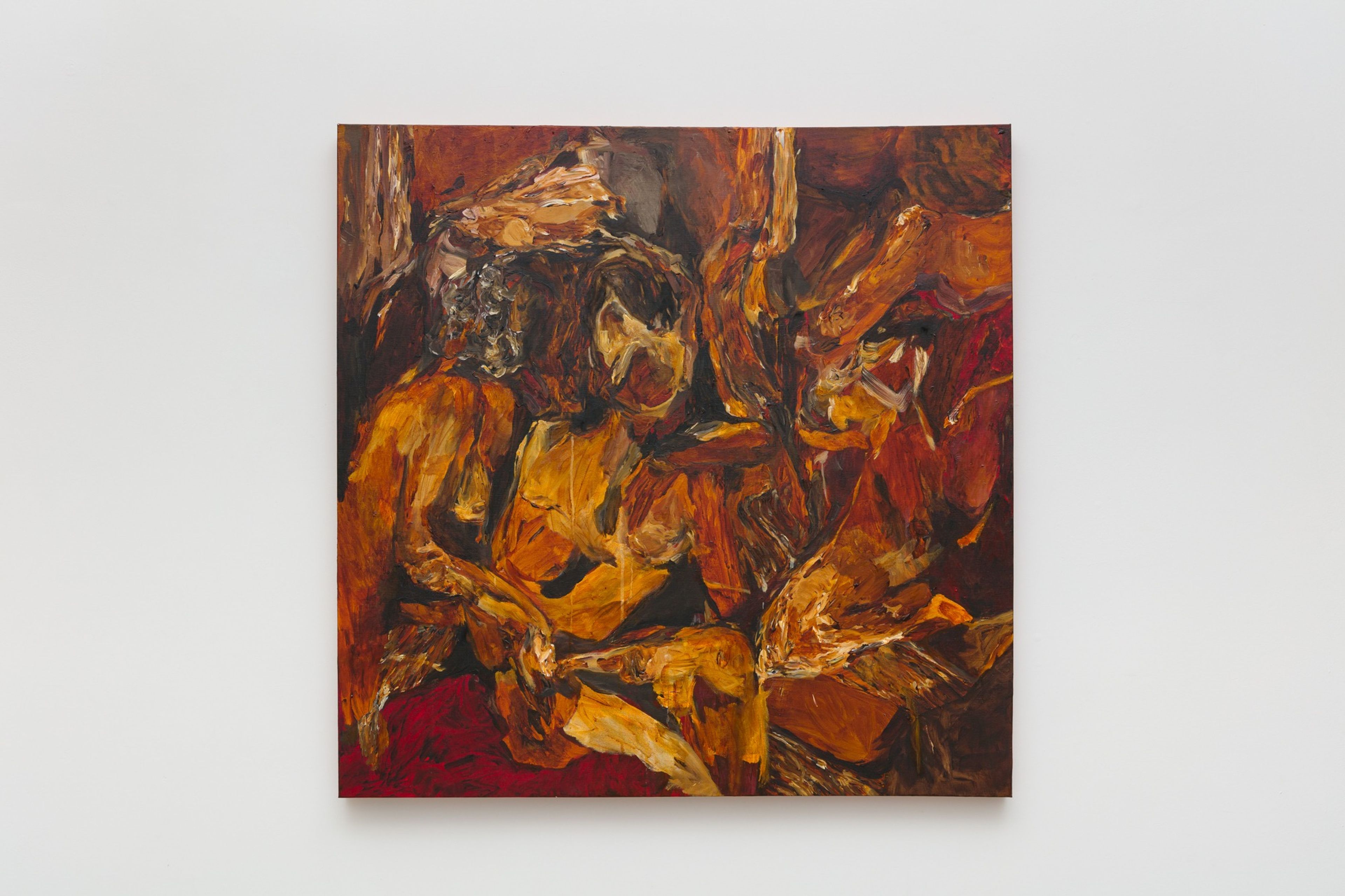
Your work explores the body as a "changeable device for sensitive experimentation." How did this idea evolve in your practice, and what initially drew you to focus on the body in this way?
I don't know exactly where my interest in the body originated, but it has always been the main focus of my drawings since I was a child. Having worked in fashion for a long time is something from my journey that continues to influence what I do today; fashion uses the body as its main medium, and during college, I did a lot of figure drawing, in all possible ways. When I went to art school, I decided to strip away that body, and I never again had the desire to cover it. I became interested in the skin as this large, sensitive, and mutable organ—what covers us and reveals us at the same time. I really like to think about erotic experience as a way of experimenting with the world, as a right that all bodies should have. Gaining experience and political awareness throughout my life, through the traumas and pleasures I’ve experienced, I began to understand how important it is for bodies oppressed by gender, class, or race to become aware of their value and the importance of experiencing the world for themselves, without the obligation to serve others. This has to do with autonomy and freedom.
You speak about inhabiting the fissures between reality and fantasy. How do you approach balancing these elements in your work, and how does this tension inform your process?
I like to create narratives from reality because imagination is a way of building new realities. By making critical reinterpretations of pornography, for example, I can use reference images that contain some form of gender violence and reinterpret them. I take the original scene and reverse the positions of the characters, add magical elements, and create new stories. For instance, when using a scene from porn where a man objectifies a woman through penetration, I reverse the characters so that the woman penetrates the man, and sometimes I include poetic elements like a sun-dildo. This fissure between reality and fantasy is magic. I like to resort to magic because it is something political and empowering. Magic is, above all, transformation. I always like to remind myself of Nadya Tolokonnikova, who says: “Magic, witchcraft, and miracles are a fundamental part of any struggle for justice. The great movements of humanity, including the Universe itself, do not operate according to a simple linear logic. By understanding this, you can maintain openness and the naive ability to be surprised, letting your thinking flow and being grateful for everything you’ve already experienced. This includes serving time in prison. The nonlinear logic of social movements demands that activists be attentive, sensitive, grateful, and open-minded creatures. Activists are pirates and witches. Activists believe in magic.”
In my case, magic is political mainly because I practice it based on Black and Indigenous knowledge, respecting these types of knowledge and all the ancestry involved in them, which has always been massacred and disrespected in Brazil. Understanding my place as an artist who, despite being mixed-race, is privileged by whiteness in my country, I am very careful to understand that I am not the protagonist in this space. I am a learner and must always place myself in a position of listening. At the same time, I find it extremely important to amplify the strength of these ancestral powers and knowledge in order to make a shift in collective thinking and increasingly materialize the dignity, power, and autonomy of these peoples.

Your paintings challenge the male gaze and traditional depictions of sexuality. How does your research into phallocentrism and poetics of passivity translate into your visual language?
I am very interested in questioning the gaze in the history of art. Because the gaze is power. The gaze is telling the story. The gaze is choosing which memories remain and which will be forgotten. And this resonates through generations, defining which bodies will have the freedom to experience the world autonomously and which will not. So, I like to think about the male body, which has always been the owner of the gaze, the active body that imposes its narrative on others, in a place of fragility and passivity. Placing the objectified male body in painting is something that creates strangeness, and that’s precisely why I was interested in doing it. Because strangeness exposes things that the gaze doesn’t usually question when it is accustomed. So, my questioning of phallocentrism is not a question of the phallus itself, but of masculinity as the power structure of patriarchy. I then began to think of active women penetrating men with the most diverse types of phalluses, from fingers to strap-ons, confusing gender roles. But in an even deeper layer of research, I began to observe that, although the penetrative being is considered powerful, there is also power in passivity. The problem lies in defining these concepts and the bodies related to them, making it impossible to subjectify a more interesting and free sexuality, which ends up reverberating throughout the structure of our collective relations and even with the environment.
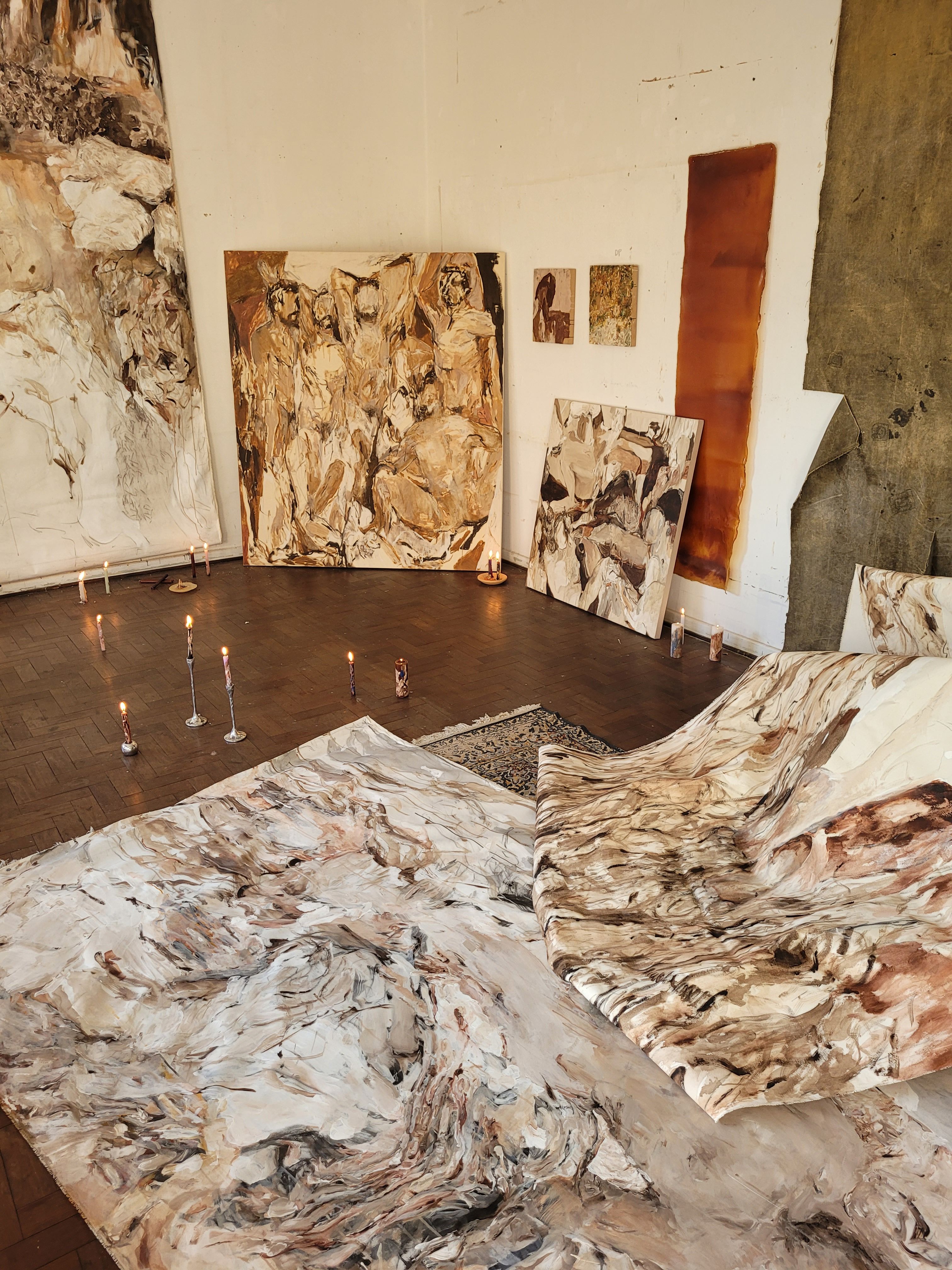
Movement and layering seem integral to your practice. Can you discuss how you use these techniques?
I believe that the layering of elements refers a lot to psychological and emotional issues, which are very deep and difficult to understand. I am interested in ambiguity, contradiction and strangeness. Movement may be the most important element of my work for me, as everything is related to constant transformation. All of this reinforces the subjectivity of the work, as if it were a forest full of possibilities. I like to think of the forest as a state of mind, of thought and feeling, that overlaps with the idea of monoculture in a broad sense, which standardizes the entire human experience. This idea of opposition between monoculture and forest comes largely from Geni Núñez, an amazing Guarani indigenous thinker. I enjoy using earthy tones because they refer to the infinite possibilities of skin tones, but they also refer to the earth itself, the place where everything is born and dies. I even use many natural earth pigments, especially those from Minas Gerais, to reflect on belonging and memory. In my scenes, there will always be oppressed bodies freeing themselves from oppression, having fun and experiencing pleasure in some way, always in motion, alive. Ambiguously, these scenes could also be seen as bodies in decomposition, but death in this case is more about transformation than an end. It’s a thought about bodies that are not afraid to change, to die many times and be reborn many times. Brave and curious bodies. I think a lot about what Clarice Lispector wrote: “I was leaving my bodies along the way”, or in Portuguese: “Fui deixando meus corpos pelo caminho”. Lispector is a big influence on me.
You mentioned you incorporate biblical research into your painting process. What does this look like? Are there particular texts or theories that have been especially influential?
I read a lot about the topics that interest my work. Paul Preciado and Donna Haraway are, at this moment, perhaps the authors who most directly influence me. As a result, my work has been finding a representation of bodies that are increasingly fluid and undefined, something enigmatic and mysterious to be deciphered. I like to think of this body that exists beyond a binary logic, becoming nothing but a mutant infinity of possibilities. I’m very interested in the cyborg body, the body that transforms, removes and adds natural or artificial elements, the relationship of this body with the environment and its animality. Recently, I created a series of magical octopuses as a poetic way to think about fragile male bodies with phallic tentacles, but also a lot of holes that can be penetrated. Thinking about gender fluidity and the poetics of penetration has also added a psychological layer to my work. I believe that the abstraction that blurs these figures allows for thinking about what it means, psychologically speaking, to want or not want to be penetrated, or to want or not want to penetrate someone. Thinking about emptiness, about the temporary filling of holes that the other may represent.
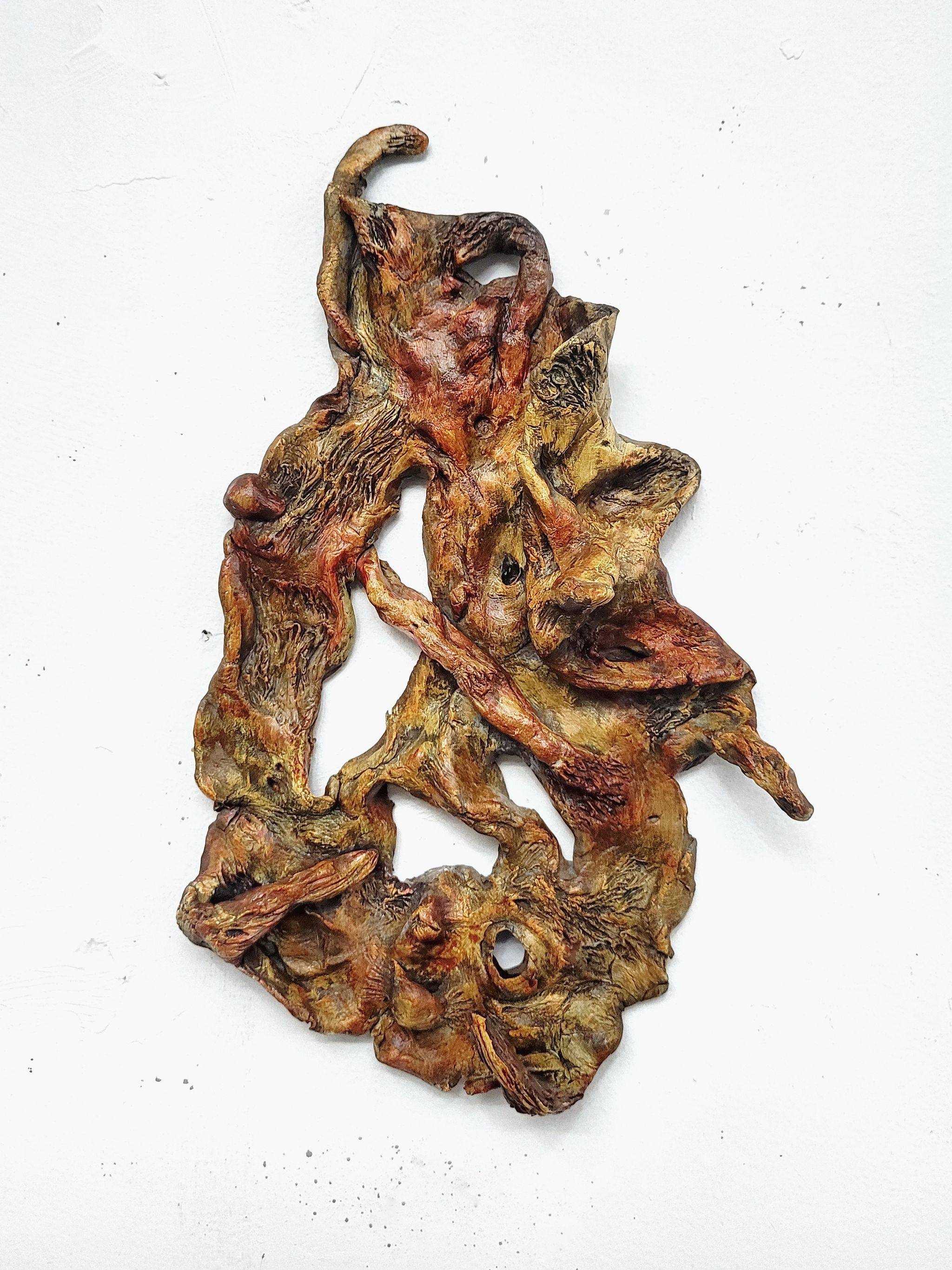
You live and work in São Paulo! Can you share more about your experience in the city and how it has influenced your art?
São Paulo is a gigantic, diverse, and extremely contradictory city, with immense social inequality. As the largest art market in Brazil, it is a city that attracts professionals from all over the country and abroad in search of opportunities. This creates many possibilities for exchanges in every sense, and this has certainly influenced and continues to influence my work. Here, I have been building an alternative family, forming deep bonds with people I love and relating erotically to the landscape. I enjoy walking the streets aimlessly, observing things actively, noticing the small poetries in subtle things, but always very attentive to the problems as well. Thinking about the market and all the complex issues related to it, being here also teaches me a lot about the reality of how things work, deconstructing many idealizations I had about what it means to be a professional artist in a capitalist system. Only time allows the artist to gain experience and understanding about the possibilities of producing and negotiating this production with the market demands, what their limits, desires, and possibilities are.
What’s your artistic process like? How do you start a painting?
My process is quite non-linear, with many things happening simultaneously, going back and forth, from readings to personal experiences of my own body that end up becoming paintings. For a long time, I drew bodies in motion, creating ephemeral works in the streets or using materials with a short lifespan, observing the bodies of dancer friends in motion and creating abstract bodies. Then, I started working from references of porn films, where movement is also a very present element. Currently, more aware of the psychological layer of my work, I always begin with some spontaneous movement and follow an intuitive way of composition and material experimentation, almost like an erotic negotiation game with the material, because it is also alive—it responds or not to our actions, and doesn’t always react the way we want it to. So, it’s quite an accidental and attentive process until I begin to notice possible figures forming, and then I work more on them. I try to detach from the outcome and the right or wrong, and incorporate mistakes and frustrations until I find something interesting. My work is very much about accepting uncontrollability and seeing it as an opportunity.
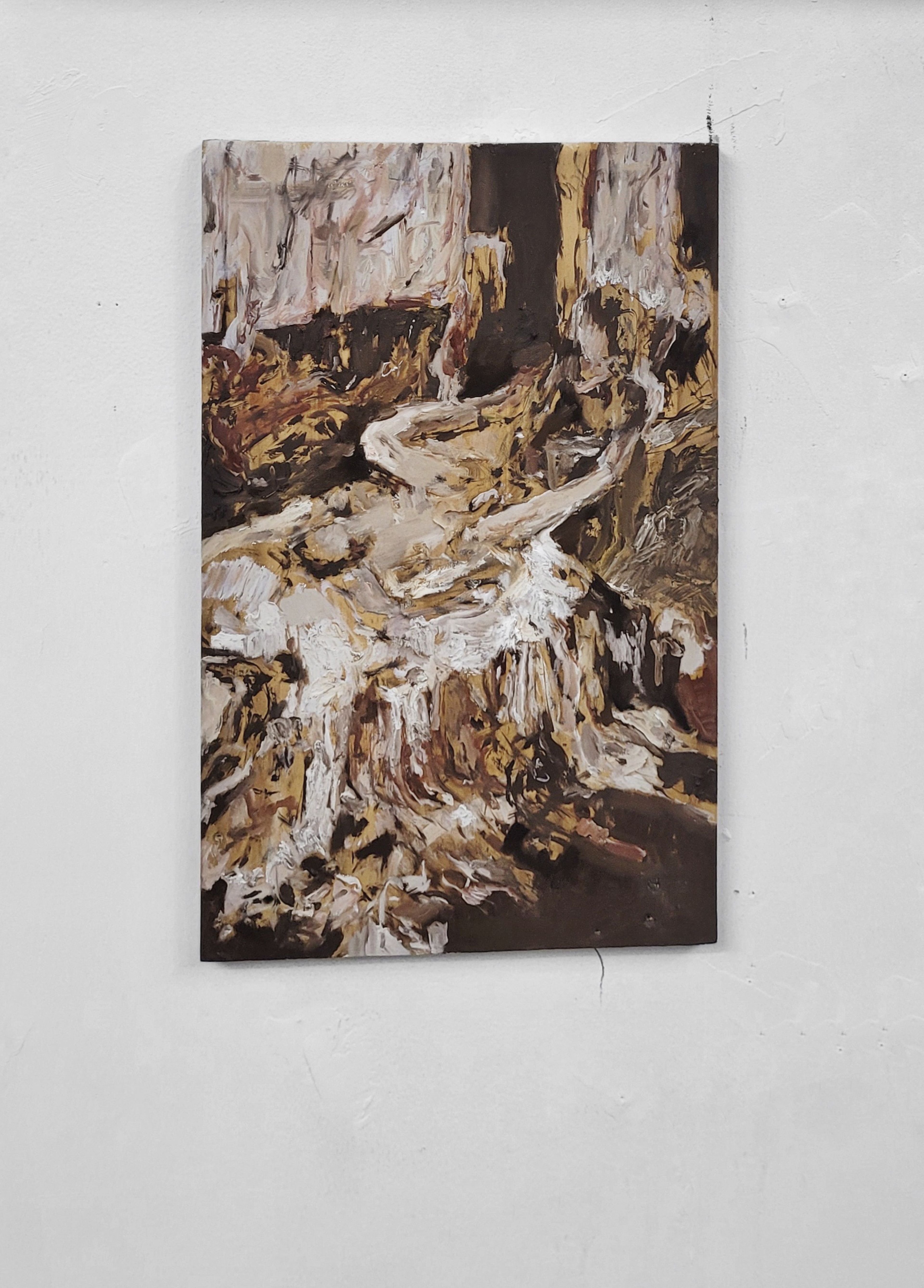
What future projects or themes are you interested in exploring next in your art?
I’m starting to delve into encaustic, a technique with hot wax and pigments that allows for interesting volumes and textures, but also many possibilities for excavation and scraping. It’s a technique that reminds me a lot of memory, as I can either add layers or remove them. Being a hot technique, it also leads me to think a lot about the living, erotic, and pulsating body. And speaking of adding layers, I also have a painting-performance called “Ways of Licking Time,” where I set myself the task of painting it while I’m alive, without ever selling or parting with it, stopping only to exhibit it in shows. I make this painting on a small piece of wood so that I can easily carry it with me, and I photograph each version before it gets covered, creating a series of photographs. The layering of paint will keep getting thicker, transforming the painting into a sculpture as well. I hope to live a long time so that it becomes really thick (laughs). In the coming years, I see myself continuing to explore bodies in celebration, something that is becoming increasingly difficult in times of climate collapse. Celebrating and feeling pleasure in the world today is a form of resistance, especially for marginalized bodies. I remember that at one point, an AI read my work as a representation of human decay. I found it funny and interesting, and I thought that maybe it actually is, because even though my intention is always to represent pleasure and celebration, I only do so because I see so much ugliness and violence in the world, and I keep thinking about ways to deal with them.
What does a typical studio day look like for you?
I don’t have a specific routine; I’m always adapting to the demands that often happen outside the studio as well. Projects, bureaucracy, documentation, relationships, logistics, planning, lots of computer work, plenty of reading and writing. I write a lot about my processes and have many texts. It’s a full-time dedication. I also teach painting and drawing. But when I’m in the studio, I like to be fully present and create an environment that inspires me — lighting candles, playing music, using essential oils, singing and dancing. It's all about the rituals, anyway.
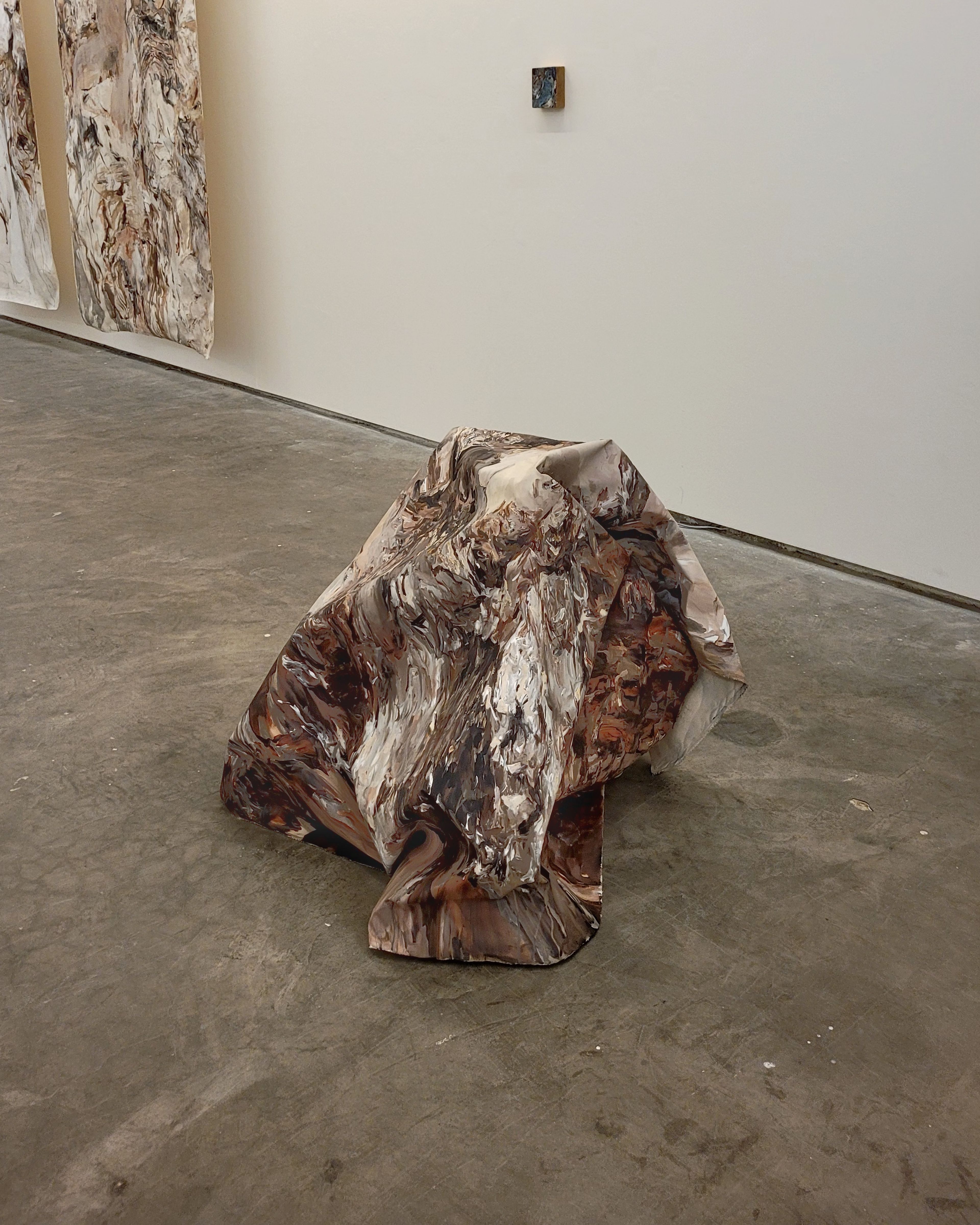
Who are some of your influences?
I am influenced by random things, from smells and sounds to films, things I overhear people talking about on the street—everything can bring me something interesting that might relate to my work, so I’m always paying attention. Within what has been absorbed by the art market, I look a lot at the work of female performance artists from the 1960-80s, especially Ana Mendieta. I also look a lot at Márcia X, Carolee Schneemann, Lynda Benglis. For some years now, I’ve also been researching artists working from ecofeminism and the ecosexual movement, like Annie Sprinkle. In 2022, I made a painting called The Little Death, where I used as a starting point an image reference from a performance by Sprinkle and Elizabeth Stevens where they have sex with the earth, as a threesome. In my painting, while they can be seen as if they are lying down having sex, they could also be seen as if they are buried. But, as I said, the morbid characteristics of my work do not have a bad or final meaning; they signify renewal. I am influenced by Brazilian Baroque architecture as well; there is so much there that interests me.
Can you share any specific experiences or sources of inspiration that have had a profound impact on your artistic journey?
During the pandemic, I left an abusive relationship and had to face a very difficult personal and collective context at the same time. This drained my libido for a while and also paralyzed me. I spent almost a year trying to heal, turning to anything that could help and grappling with many internal monsters. After that time, in which I died several times, I went to meditate in nature and had a huge orgasm with squirt, without any bodily stimulation, just by controlling my breathing and my mind. During that orgasm, I lost track of time and my body, as if my body had come apart and I was everything and nothing at the same time. I don't know if that lasted seconds or millennia. I know it completely transformed me. Because it was as if I had been born again, that squirt was like a water bursting in the birth of myself. There, I understood how the mind has power over the body and over material reality as a whole. I also understood how sexuality can be empowering and healing. Since then, I became obsessed with diving deeper into sexuality, because before that, I thought of the body in motion and its ephemerality without a closer connection to the erotic. It was a turning point. I have a painting-installation called "No dia em que chovi, o céu desabou brilhando," which can be translated as "On the day I rained, the sky collapsed shining," and it is about the experience of this squirting-orgasm. Then, I had a solo exhibition called "Água Viva," based on my favorite Lispector book, and on this experience of mine. From that moment, I understood that my body does not exist to please others, but rather to enable me to experience life my way, to chart my own path as a free person. And that’s how it has been to this day, and this is what my work is about. I know that this can be inspiring for many people who have experienced trauma like I have: it is always possible to be reborn in a more powerful and magical way.
